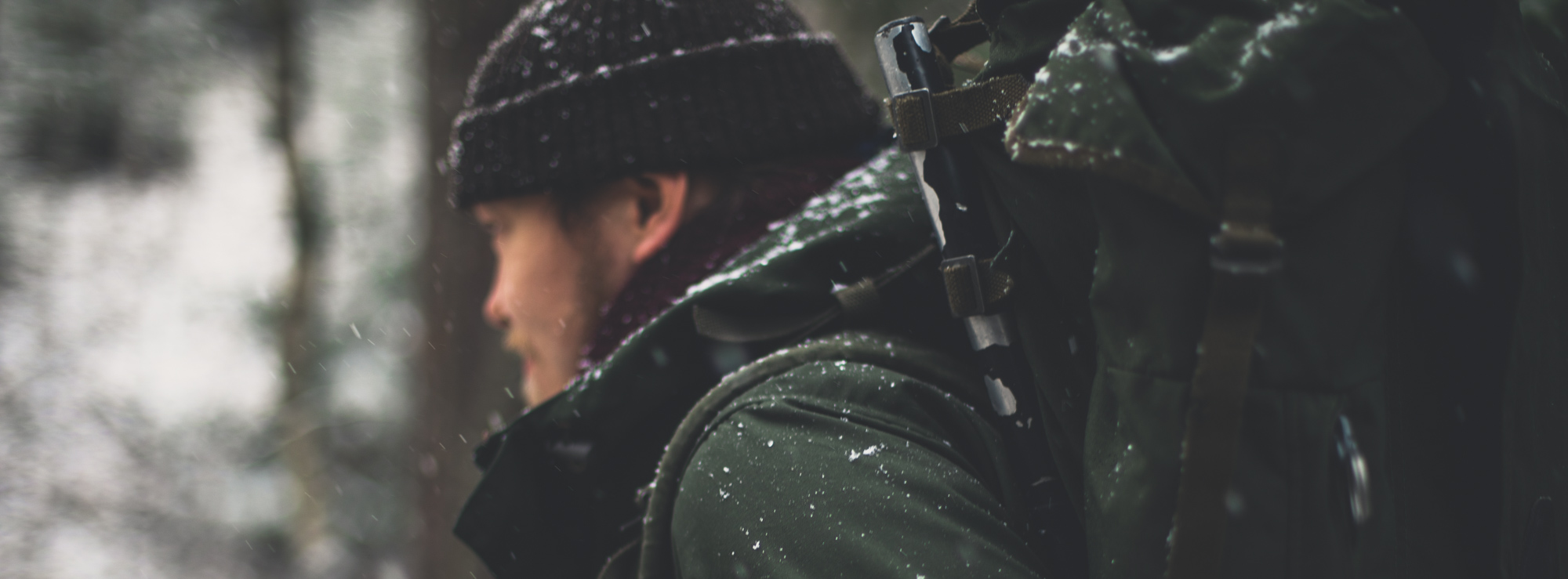
Winter hiking gear list
Winter hiking gear list
When you’re planning a wintery hike, the first logical step is the hiking trip packing list. This hiking essentials list is a simple way to make sure that you don’t forget anything crucial. The contents of the hiking packing list vary based on the destination, trip length, how cold it is, how much snow there is, what you plan on doing there, and your personal preferences. Therefore it is impossible to create an all-inclusive list. The list for a wintery ski trek in Lapland will understandably be very different from the one you use when packing for a hiking trip in Hawaii.
We concentrate on a winter hiking equipment list because including all the seasons would make this a very long article and the gear selection is more crucial in a cold climate. This article is more of a winter hiking gear list for beginners since those who have been doing winter camping for a long time usually already have their own lists.
We divided the gear chaos into a bit more manageable groups and added two winter hiking gear list examples at the end. When you plan your first packing list for hiking, it might help to look at these first. The first hiking list is for day-tripping and the second hiking pack list is for longer ones.
Clothing and footwear
In the Arctic, clothing selection for winter is more complex than for other seasons. When packing a backpack for hiking, winter clothes also take more space. When you’re on the move, you need cool enough clothing so that you won’t sweat like a hungover hog but warm enough that you won’t freeze to death. A good rule of thumb (or as we say in Finland, the rule of fist, which sounds more badass) regarding winter hiking clothes is that you should feel a bit cold in them in the beginning. Once you start moving, you get comfortably warm but not overheated.
Then when you’re having a longer break or sitting in the camp, you need enough dry and warm clothes. In a sub-zero climate, it is impossible to dry your sweaty clothes if you’re not allowed to make a fire. Thus, you should bring enough spare clothes on longer trips. In case you can have a campfire, you basically only need two merino wool undershirts and two pairs of long johns for hiking. One set on and one in the pack after drying it by the fire. Two pairs of merino wool socks are also enough if you have really warm boots or it isn’t super cold. If you wear doubles, stay long and move a lot, plus there are no drying opportunities, add more.
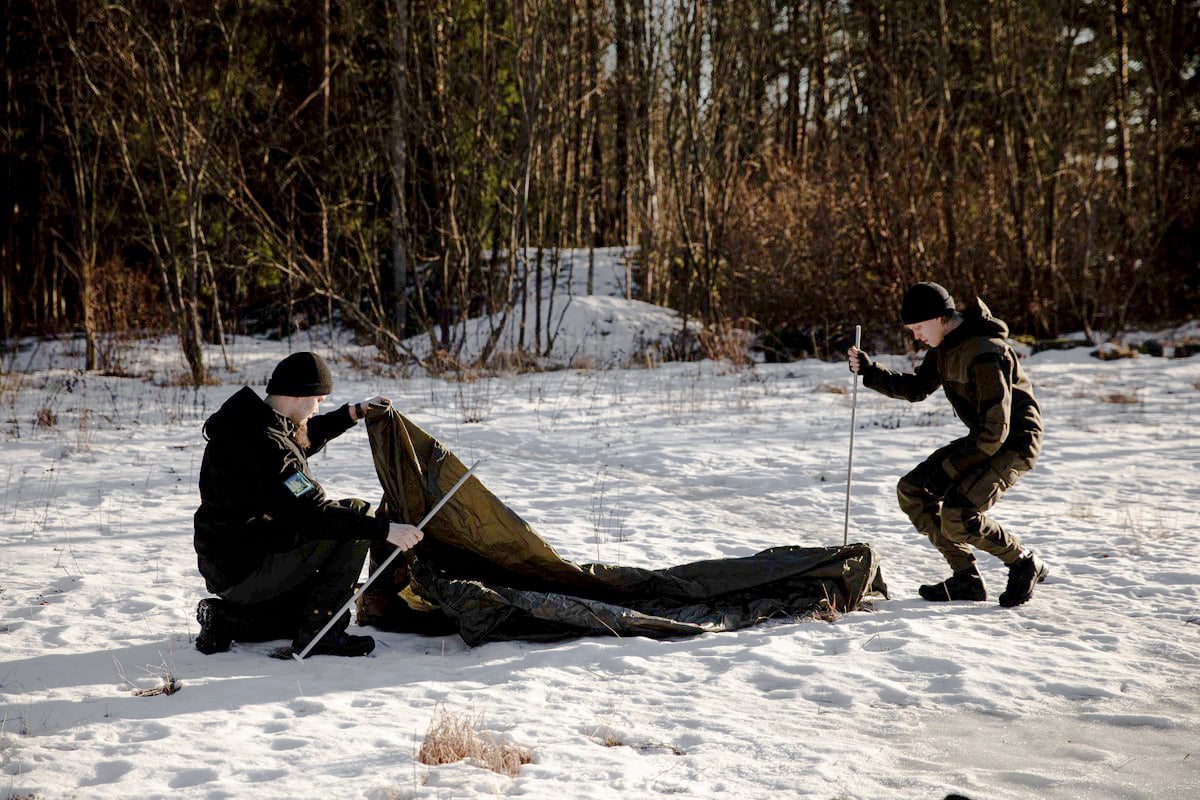
If you sweat a lot, you should have less clothing on during all activities than when you sit in the camp. This way you keep your warm stuff dry.
When selecting footwear for your hiking backpack list, you need to consider the temperature, snow depth, and what you plan on doing during your trip. Ice fishing may call for rubber boots if there’s a lot of water on top of the ice. Traditional Finnish wilderness ski bindings require a special type of boots made for such bindings in mind, but modern snowshoes or skis that use similar bindings work with pretty much any winter footwear. Thick snow calls for tall boots or waterproof gaiters, and so on. You might want to bring a second pair with you in case your boots get wet or thick wool socks for the time it takes to dry your boots by the fire.
There are many material choices for clothing on the market from technical to traditional. Personally, I prefer breathable layered clothing and as natural materials as possible. Below you’ll find my clothing choices for wintery outings. If it is cold as hell, I will add more layers, especially when in the camp. If I go bird hunting, I add a snow camo outfit on top of everything. When you buy any new clothes, test them first on shorter trips to find out how you like them. This way you won’t be nastily surprised in the middle of nowhere in a blizzard.
Clothing on the move- Särmä Commando Cap, Merino Wool
- Särmä TST Woolshell Jacket
- Särmä TST Woolshell Pants
- Särmä Merino Wool Long Sleeve Shirt
- Särmä Merino Wool Long Johns
- Särmä Hiking Socks, Merino Wool
- Salomon Toundra Forces Winter Boots
- Austrian Gore-Tex Gaiters, Surplus
- Mechanix ColdWork Original Winter Gloves
- Thicker gloves when it is colder than -5 degrees Celsius (23 F)
- Särmä Merino Watch Cap
- Särmä Heavy Neck Tube, Merino Wool
- Särmä TST Woolshell Jacket
- Särmä TST Woolshell Pants
- Thick 100% woolen sweater
- Särmä Henley Shirt, Merino Wool
- Särmä Merino Wool Long Johns (second pair)
- Särmä TST L2 Long Johns, Merino Wool
- Särmä Hiking Socks, Merino Wool (new dry pair)
- Salomon Toundra Forces winter boots
- Mechanix ColdWork Original Winter Gloves
- Thicker gloves on top of the Mechanix
Stuff for carrying all that crap
The size of your pack depends on the length of the trip and your packing ability. If you don’t want to support an expensive pack habit but like to do both short and long trips, get a 30-40-liter day pack for short trips and an 80-liter backpack for the long ones. The modern modular backpacks are nice because you can increase the capacity by adding more or bigger pouches. You can also bring the day pack along on a longer trip and use it for shorter hunting, fishing, photography etc. trips from the base camp.
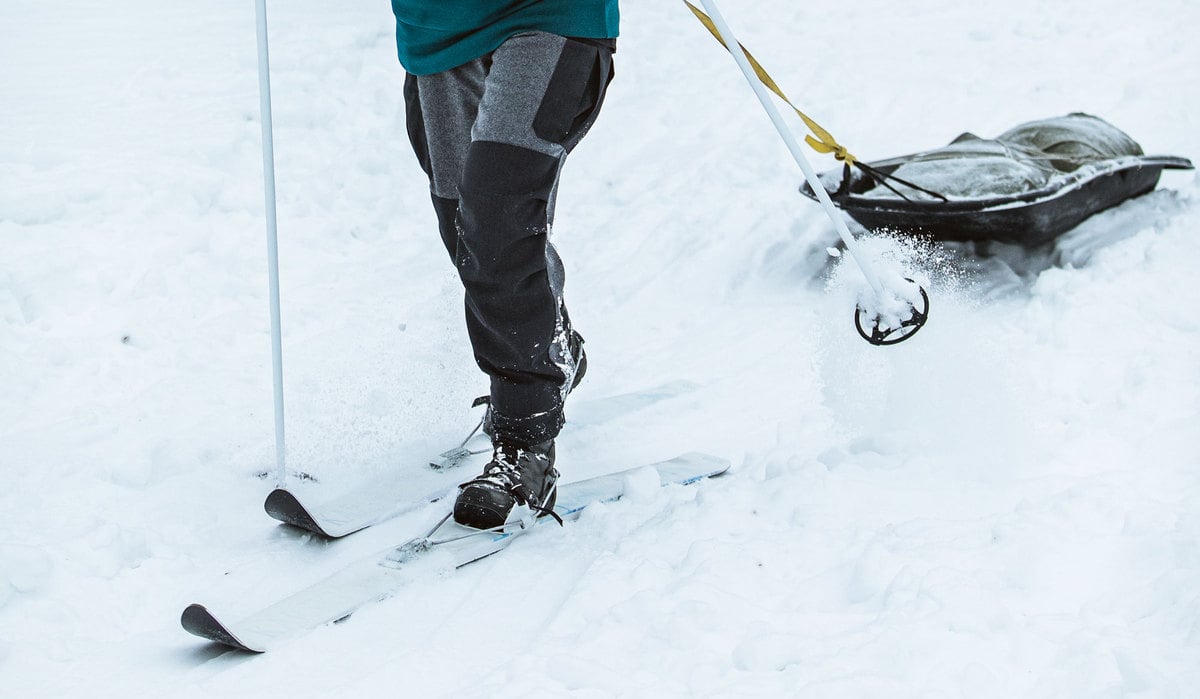
An expedition sled helps you on a wintery hike. When the terrain isn't hilly, you can manage without a hauling shaft.
If your packing list for hiking looks like an episode of Hoarders, a Finnish contraption known as ahkio can help. Ahkio is an expedition sled that you pull with skis, snowshoes, or on foot if there is little snow or the snow is hard enough to carry your weight. It makes those long trips possible because it will carry a lot more than your backpack. And if needed, you can also have a pack on your back. Expedition sleds are fantastic also on shorter trips, especially when the thick snow doesn’t carry you with the backpack on your back. If the modern high-tech expedition sleds are too pricey for you, you can do what I did and modify your own from a cheap plastic sled, a BW rain poncho, and a handful of elastic octopus straps. You should get a proper harness though plus a hauling shaft if you move in a very hilly terrain.
Camping
When you’re daytripping, you can skip this part completely. However, when you stay for one night or more, you need some sort of a camping plan with enough essential gear. What you carry depends on the length of the trip, snow depth, weather conditions, and your own comfort level. You will usually at least need some sort of a shelter, a sleeping bag, and a sleeping pad. On top of that, add more gear based on your needs and wants.
For those who wanna travel light, the options are a bivy bag, tarp, hammock, and a snow shelter, known in Finland as lumikammi and e.g. in Canada as quinzhee. You should not try to build a snow shelter on your own though if you haven’t done it before. There are several things that can go fatally wrong if you don’t know what you are doing. Those who like more comfortable living should bring along a tent. As a bit of a history buff, I prefer a cotton canvas loue shelter, which is a traditional Finnish shelter type. Practically as heavy as a tent but not nearly as sheltering, but still absolutely fantastic.
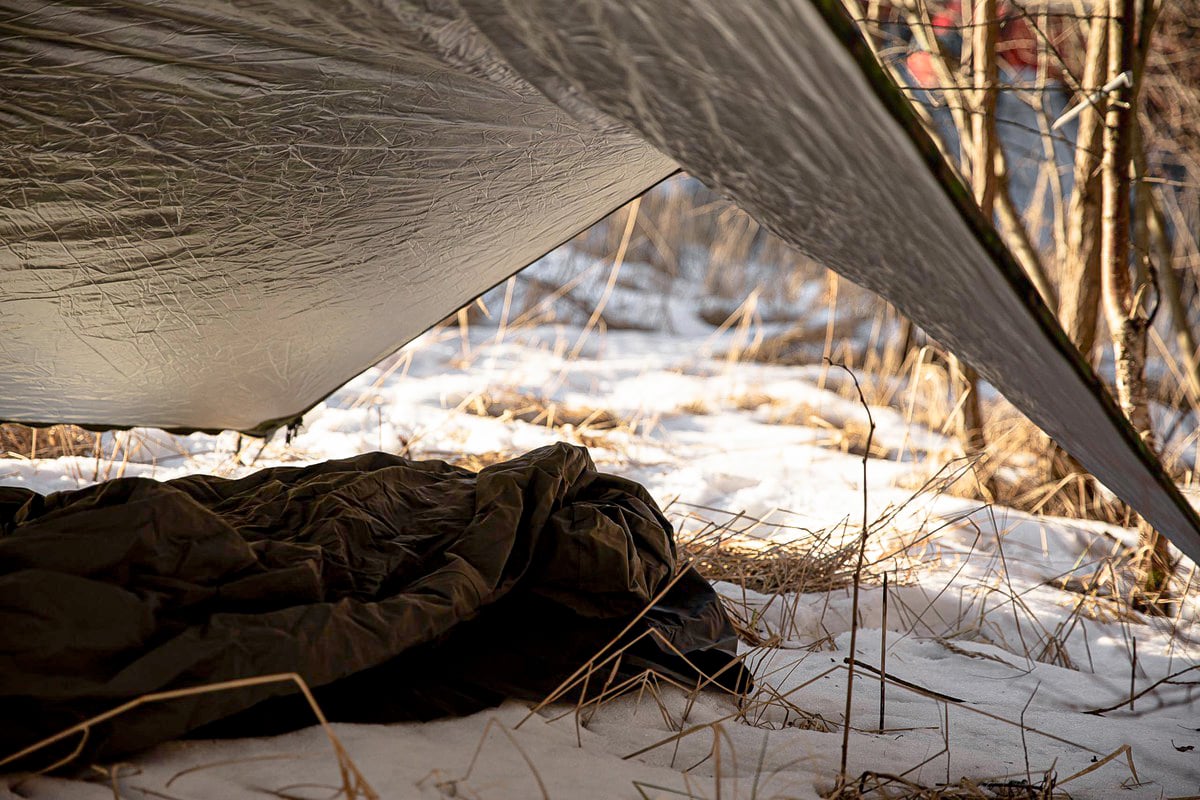
A minimalistic winter camper does just fine with a shelter made from a tarp or rain cape, especially when it isn't Lapland cold.
A winter sleeping bag is nowadays pretty much a must because you cannot build a rakovalkea (a traditional Finnish slit fire that lasts the whole night) in that many places anymore. Of course if you have a tent stove, you can manage with a thinner sleeping bag. However, something can always happen that kills your fire plans, so it is worth it to have a warm enough sleeping bag in which you also survive without additional heating.
The sleeping pad selection is at least as important a step as the sleeping bag selection. Many make the mistake that they acquire a very warm sleeping bag but spend an unpleasant night freezing like mad on top of their thin, age-old, and squished foam pad. When you lie on top of your sleeping bag, it gets compressed. Thus you need a well-insulating sleeping pad to prevent the cold from creeping in from below. I use two pads, a “waffle-style” foam pad at the bottom and an inflatable one on top of it. Since I sleep in an open shelter, I put the BW rain poncho (that covers my poor man’s expedition sled when on the move) beneath these two to keep the snow away. In tents, some use a space blanket.
Don’t crawl in the sleeping bag with all outdoor clothes on. They will bring moisture inside the bag. Furthermore, if you have too much stuff on, you will first get too warm, then the drying sweat will make you very cold. It is a lot better to wear merino wool long johns and a long-sleeved merino wool undershirt. Possibly keep another wool layer inside the bag in case you need it. I also wear a wool balaclava and on top of it a merino wool cap plus a thick merino wool neck tube in very cold weather since I don’t like to mummify myself completely inside the bag.
For a pillow, I put my thick woolen sweater inside the sleeping bag compression bag. There are also various pillows for hikers available but I don’t want to carry extra stuff when this system also works.
If you have never slept outdoors in winter, I recommend practicing it close to home on short trips and not in mega cold weather with a friend before going on a more challenging adventure in Lapland.
Food
For a couple-hour outing, you don’t need much food. However, easy-to-eat snacks, such as sandwiches, jerky, dried fruit, chocolate, and protein bars are nice to have if you ski or hike in difficult terrain with craploads of soft snow. For longer trips, you wanna bring some warm food as well. The easiest option is dry or wet hiking food. You can of course bring along the ingredients and make a gourmet bush feast from scratch or complement your diet with hunting or fishing, if possible. Or combine these all.
How much food you need depends on how much you like to eat and how much you consume. Longer and heavier the hike, the more food you need to bring. The basic set is a breakfast, lunch, and dinner each day plus snacks based on your activity level.
Water
You can survive a bit longer without eating but drinking is a must or you won't go that far. On a short outing, it is usually enough to bring a full water bottle or hydration reservoir. When the temperature is below the freezing point, water will eventually freeze if you don’t carry it close to your body. Booze won’t solidify that easily but you probably shouldn’t try to hydrate yourself with it.
On longer trips, all water you bring will freeze, so it isn’t very practical to carry much of it. The sensible options are: turn snow into water by boiling, use running water from rivers and streams if they haven’t yet frozen, or make a hole in the ice. The hole is a good solution if the ice is thin or you camp in one place for a bit longer. You will just need to keep it open. If you’re constantly on the move and the ice is very thick, it takes a lot less energy to boil water. If you’re not sure about the water quality, boiling is always the safest bet. Water filters will freeze in these conditions.
Camp cooking
Your stove options for camp cooking are either a camping stove or open fire. The traditional Trangia comes with the cookware but for most gas stoves, the hobo stove, and for open fire you need to buy them separately. If you use modern hiking food, you can prepare it in the bag thus eliminating the need for a kettle. A camp fire is very atmospheric, and here in Finland the designated fire places along hiking routes often have firewood, but not always and especially not in the most remote places. Other countries have their own systems and regulations, and you need to be familiar with them when planning to have a campfire. If you’re in the middle of nowhere and there’s snow up to your groin, you will have a hard time finding enough firewood even when using natural wood is allowed. That’s why you should have some sort of a stove with you even if you plan on open fire cooking.
Additionally, you need a ladle to stir and scoop plus the cutlery and dishes for eating. If you like hot drinks, bring a thermos for short trips and a pot for making coffee/tea for the longer treks.
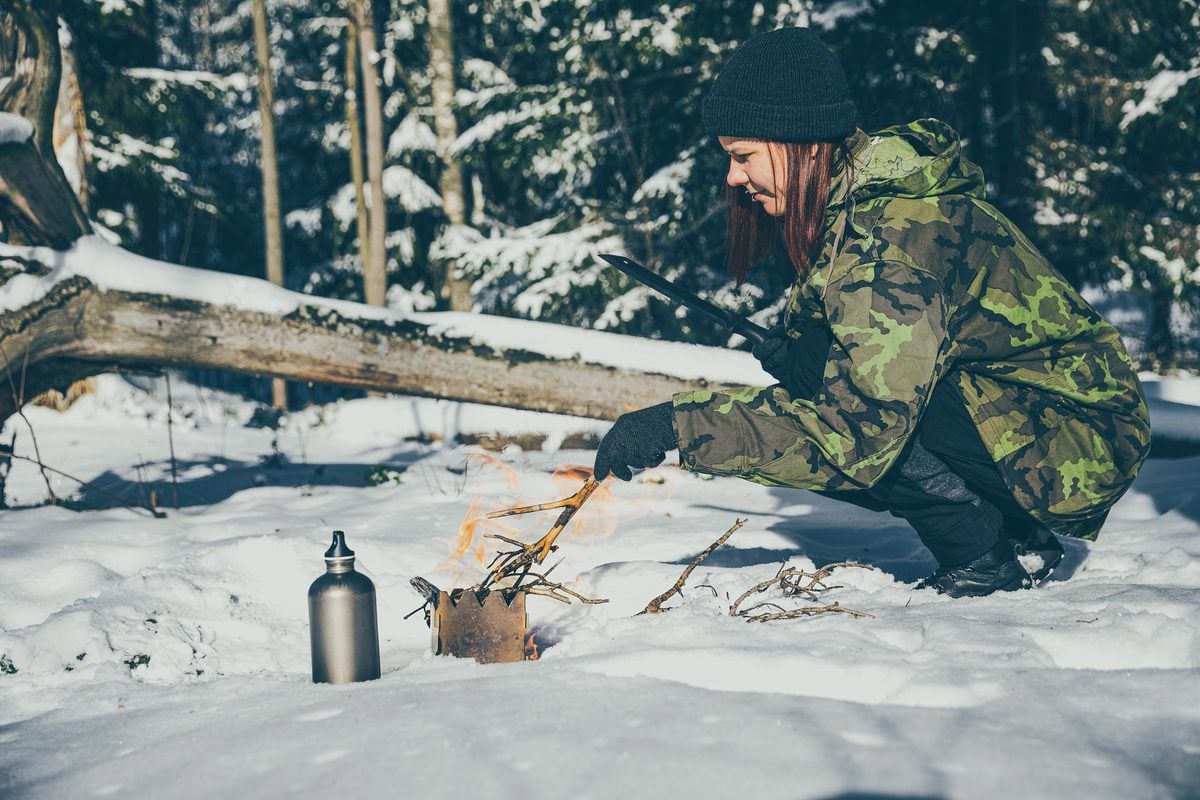
The hobo stove is a good camping stove when you are allowed to snap dry twigs or when there is not much snow.
Tools
A rugged pioneer type does everything with just bare hands and teeth but us normal folks usually need a few tools. Which ones to bring depends on how long you hike, what you wanna do, and what kind of conditions and terrain you encounter. A knife is useful pretty much on every hike. You can use it to open packages, whittle kindling, cut cordage, build this and that, and fight off the forest trolls that creep into your camp. A multi-tool can also bring you some additional happiness. If you stay in the wilderness a bit longer, an axe and/or a folding saw is often necessary.
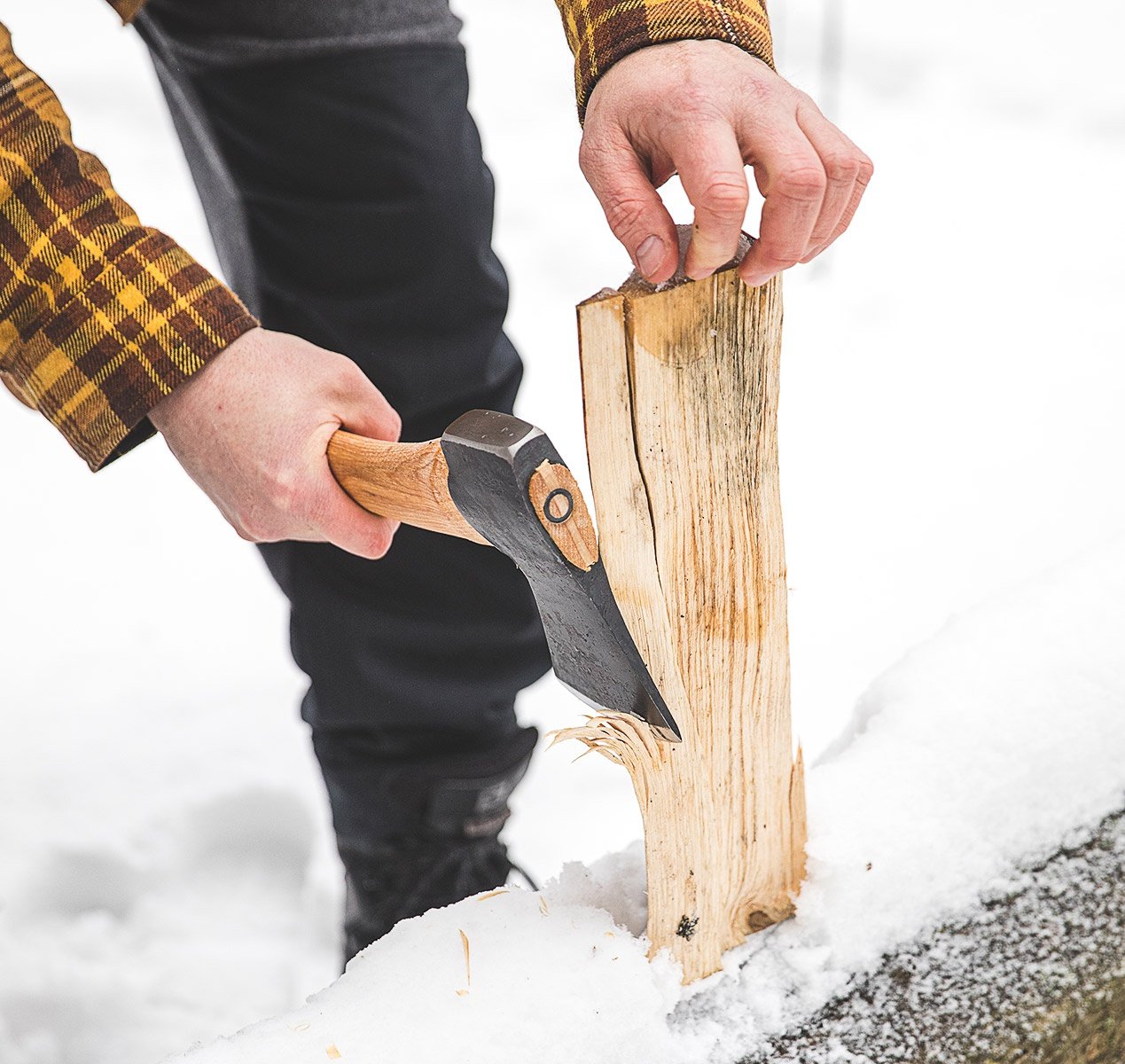
When the weather isn't overly cold, you can chop wood without gloves. However, when it is very Arctic, snugly fitting winter gloves, such as Mechanix ColdWork make it a lot more pleasant.
A fire-making kit is also a must, unless you prefer to use the primitive methods. There are many options from different matches to lighters, and fire steels. I always bring a fire steel along because it will not run out of fuel or fail when wet. You should bring your kit along for emergencies even when you don’t plan on making a fire. If you get lost and fall in a watery ditch or through thin ice on a lake far away from everything, dry spare clothing and a warming fire are your friends.
For winter hikers, a shovel is also very handy. If there isn’t that much snow out there, you can flatten a big enough area for your shelter with your feet but in deep snow, a shovel makes your life a lot easier. An e-tool isn’t the best snow-shoveling tool out there but a lot better than just your hands. If the snow is soft, you can also use a sled to scoop it out of the way. Swiss snow shovel is a fantastic tool to acquire, when we happen to have them. A spade is also handy when you return to your car after that week-long hike and you need to shovel around the vehicle to get it to move. If you have a big enough car, you can of course leave a full-sized snow shovel there.
Electricity-devouring gadgets
Nowadays the stores are full of electronic gadgets for hiking. Some prefer to hike like our ancestors did, others want all the beeping things. No matter how you like to travel, a phone is a good device to bring along as long as there is coverage where you want to go. (If not, there are often satellite phones you can rent.) This way you can call in a chopper if something bad happens. (Don’t start your hiking career by going to places where you cannot get any help.) With a phone, you can also keep the folks at home happy with messages and possibly also take pictures. Modern phones also often have a navigator in case you happen to get lost. A headlamp is also a good appliance to have. Snow and full moon provide quite a bit of light but if it is cloudy, there’s no moon, you are in a dark tent, or you need to do some precision work, a lamp is a must. Spare batteries and power banks come in handy when you stay in the forest any longer.
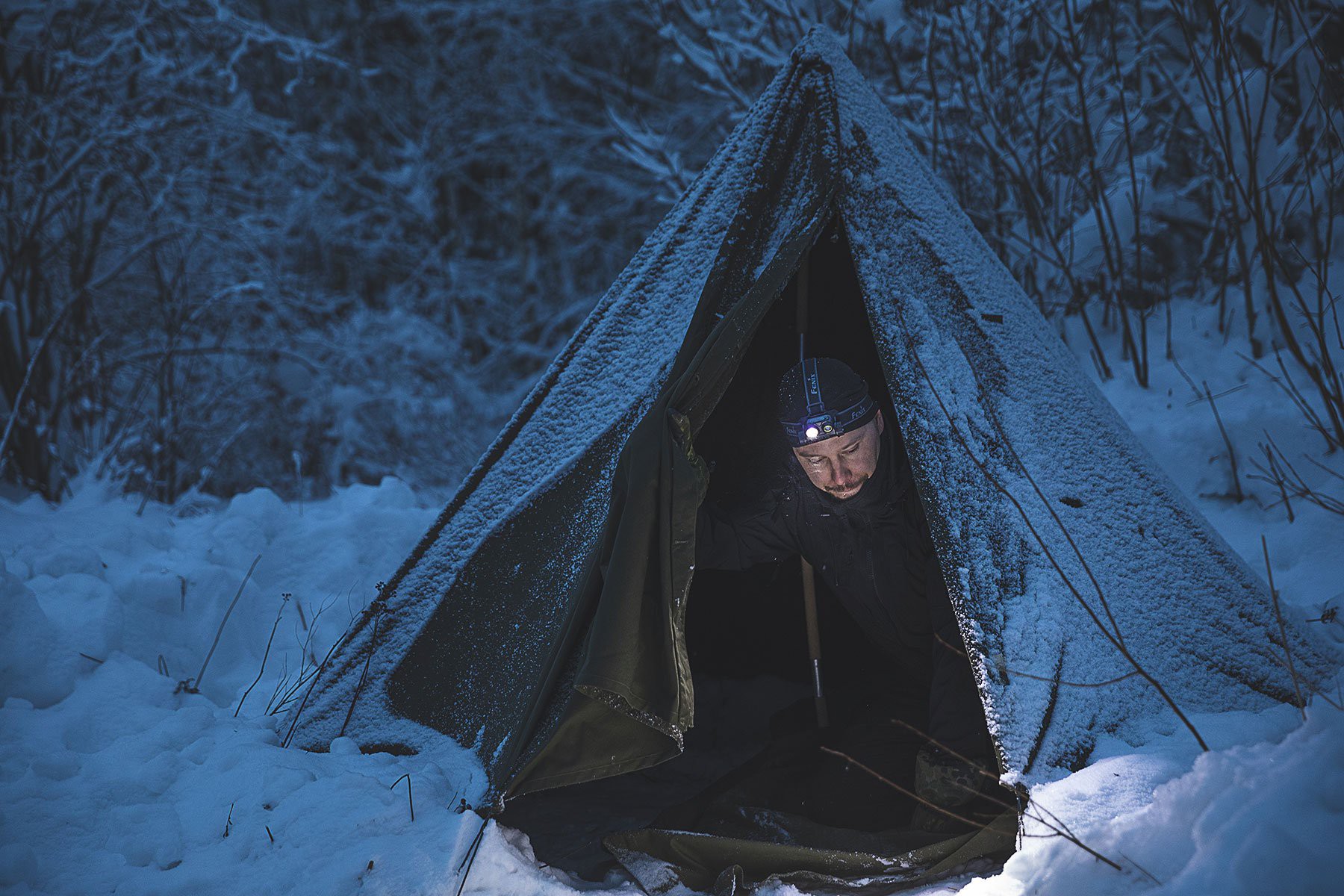
Even when the moon makes the outside world bright, a headlamp is usually a must in the tent .
Activities during the trip
A wintery outing can include skiing, skating, snowshoeing, ice fishing, hunting, photography, and many other wonderful things. Fill this slot with the essential gear needed in your particular hobby. If you start having problems with space, take an expedition sled or do less.
First aid
Anything can happen in the banjo-friendly backwoods, and a pessimist stays alive better. Just making your personal hiking first aid kit list is not enough. You also need to learn to use all that stuff, so that you don’t have to despair, when you axe your toes off or fall into the campfire.
Painkillers, band aids, and personal medication most people will remember to take along. In addition, you should bring whatever you might need in your neck of the woods. Such as charcoal tablets for sudden bottom tsunamis, and a tourniquet and bandaging material plus a space blanket for bigger oopsy-daisys. It might take a while to get help in the middle of nowhere when you make an accidental blood pact with your knife. Burn gel/cream to help you with the aftermath of accidental pyrotechnics as well as blister bandages for your feet might also be smart. First aid kits for hikers often have many of these and you can buy the rest separately. Additionally, a suitable pouch for storing everything if necessary.
Other useful things
Toilet paper is necessary for most of us. There are no toilets in the real wilderness, and even if you follow a hiking route that has outhouses here and there, the paper might be crapped out. Digging moss from underneath all that snow is a bit of a chore and might also be banned. Also wiping your ass with frozen moss is an experience of a lifetime. Toilet paper can also be used for many other things from cleaning the skillet to wiping your nose. Toothbrush and paste help keep the dentist away. On top of that, bring the other hygiene products that you might need.
Polarized sun glasses or goggles might be necessary if you ski in open terrain and the sun shines very brightly. For orienteering, a map and compass are very useful especially if you don’t use any clearly marked routes or have a tendency to get lost. The GPS sure is handy but when it is really cold, your battery might die quite quickly, especially if you use a GPS on your phone.
Example packing lists
When you’re drafting the first packing list for hiking trips to come, it can help to look at some examples. More experienced hikers can also use them as memory aids. You can easily modify the examples to suit your needs.
Below you’ll find two example lists, one for shorter trips and the other for longer ones. Long and short of course mean different things to different people. We made the division based on whether you sleep in the wilderness or not. The basic gear list is the same for both but when you stay overnight, you need to add gear required for camping and sleeping. The longer you stay, the more stuff you need but usually it means adding more food and possibly clothes as well.
Day hiking packing list
A day trip can be anything from a whole day’s skiing adventure to a couple of hours’ snowshoeing, anything where you don’t stay overnight in the wilderness. For a short hike close to your home you don’t really need much but when you venture somewhere further for a whole hiking day, packing list will be very helpful.
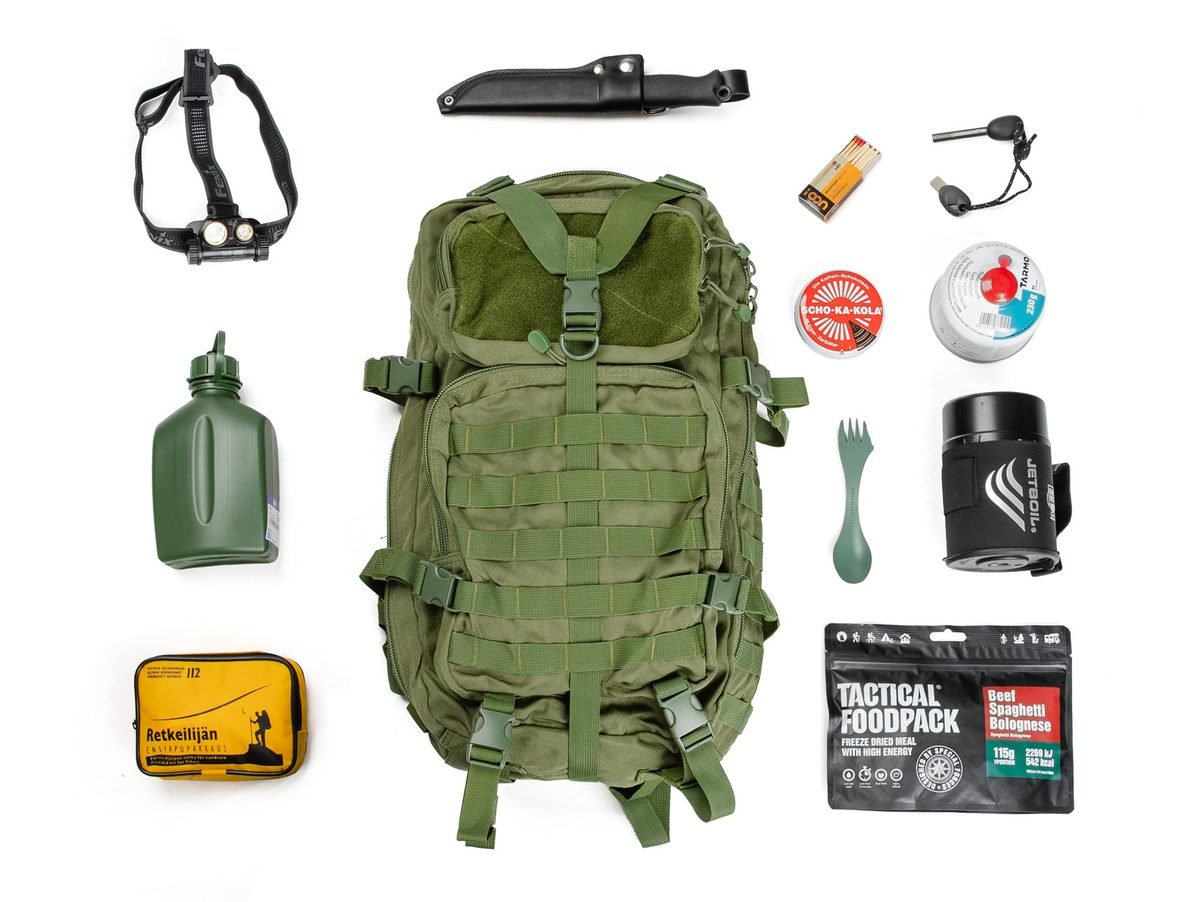
You should think about your gear and how to pack it early enough so that you can acquire what's still missing or broken, like the case is here.
Clothing and footwear
- Merino wool cap (+ a dry one for long breaks)
- Breathable jacket
- Breathable pants
- Gloves based on how cold it is
- Warm winter shoes or boots
- Waterproof gaiters (if you don’t use tall boots)
- Undershirt + long johns, merino wool (another set if you take a long break)
- Socks (another pair if you take a long break)
- A thick wool sweater or a loft jacket for breaks
Stuff for carrying all that crap
Food, water, and cooking
- Snacks and food based on the length of the trip
- Camping stove, fuel, and if needed a cooking vessel (depending on if and how you make food)
- Spork and plate (if you eat warm food)
- Hot drink in a thermos
- Water bottle or hydration reservoir
Tools and gadgets
Others
- Snowshoes and poles (if the snow is deep)
- First aid kit
- Toilet paper
- Trash bag
Hiking gear list for longer trips
When you’re planning what to bring for hiking that includes sleeping in the wild, you need to proportion everything based on how many days the hike will last. The basic setup is the same as for a day trip but you will need more spare clothing and food plus all the gear needed for camping. The friends of electronic gadgets also need enough power banks.
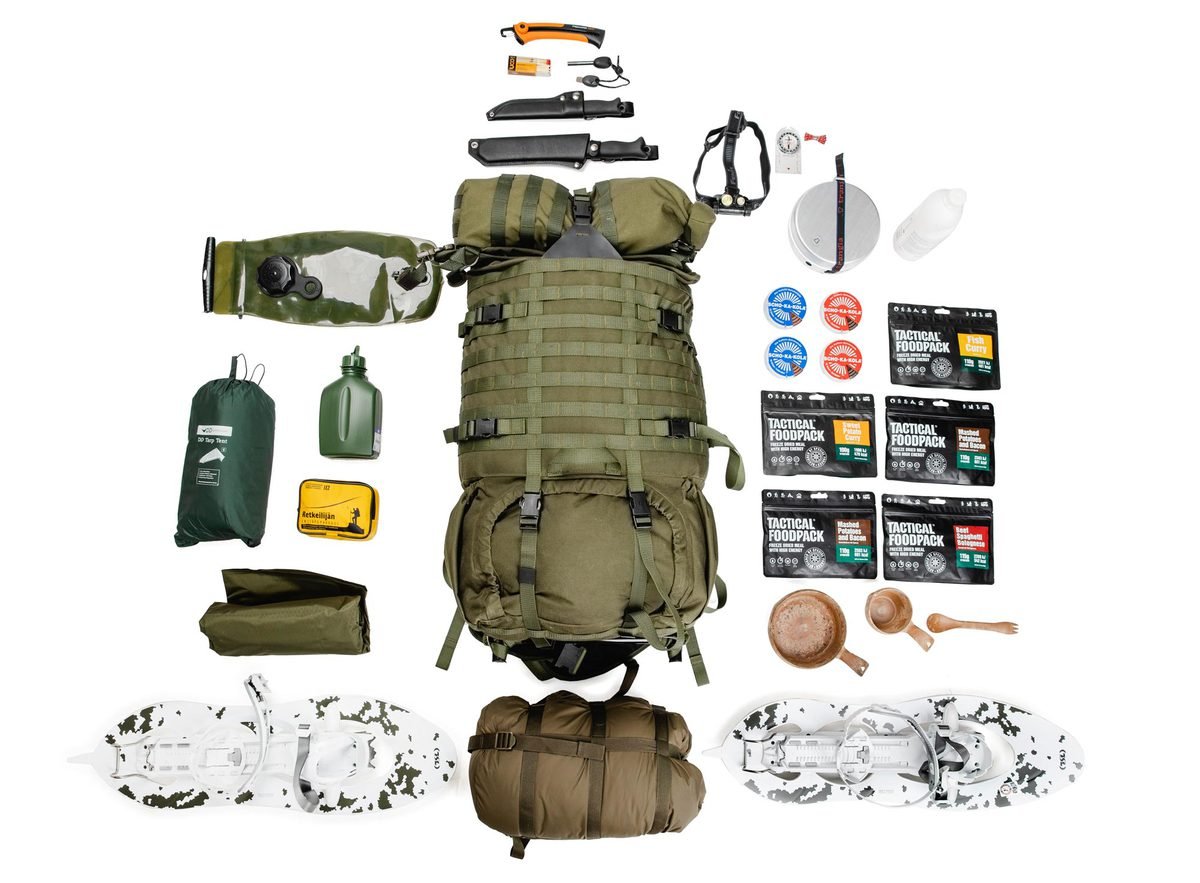
You should think about your gear and how to pack it early enough so that you can acquire what's still missing or broken, like the case is here.
Clothing and footwear
- Thinner merino wool cap for moving and thicker merino wool cap for the camp
- Breathable jacket
- Breathable pants
- Gloves based on how cold it is
- Warm winter shoes or boots
- Waterproof gaiters (if you don’t use tall boots)
- Merino wool undershirt (quantity based on the length of the trip and drying possibilities)
- Thicker mid-layer shirt
- Merino wool long johns (quantity based on the length of the trip and drying possibilities)
- Thicker mid-layer long johns
- Socks (quantity based on the length of the trip and drying possibilities)
- Thick wool sweater or a loft jacket for breaks
- Wool balaclava and a heavy neck tubel for sleeping (if super cold, then an additional dry watch cap on top of everything)
Stuff for carrying all that crap
- Backpack
- Expedition sled
Camping
Food, water, and cooking
Tools and gadgets
- Knife
- Axe and/or a folding saw
- E-tool/shovel
- Compass + map and/or GPS
- Headlamp + battery
- Matches and/or fire steel
Others
- Snow shoes or skis and ski poles
- First aid kit
- Toilet paper
- Trash bag
- Toothbrush + toothpaste
- Phone
- Power bank & cable